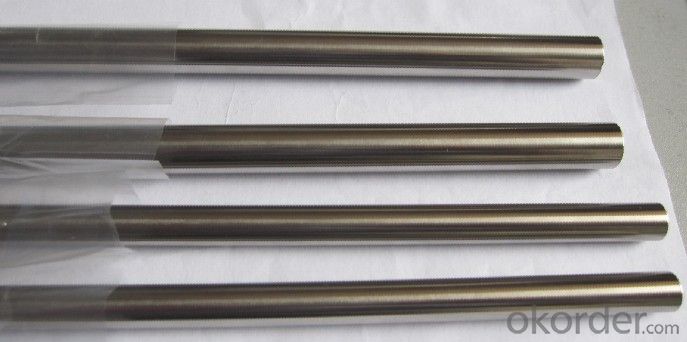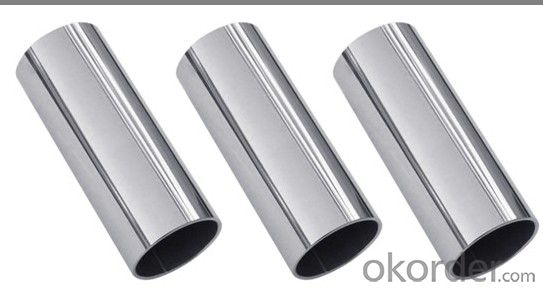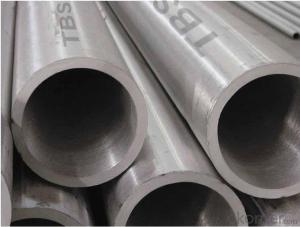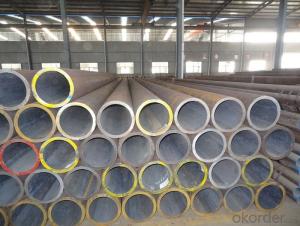A335 Seamless Ferritic Alloy-Steel Pipe for High-Temperature Service
- Loading Port:
- Shanghai
- Payment Terms:
- TT OR LC
- Min Order Qty:
- 1000 kg
- Supply Capability:
- 10000 kg/month
OKorder Service Pledge
OKorder Financial Service
You Might Also Like
(1) nominal wall and minimum wall seamless ferritic alloy-steel pipe intended for high-temperature service. Pipe ordered to this specification shall be suitable for bending, flanging (vanstoning), and similar forming operations, and for fusion welding.
(2)Each length of pipe is subjected to the hydrostatic test and examined by a non-destructive examination method in accordance to the required practices. The range of pipe sizes that may be examined by each method is subjected to the limitations in the scope of the respective practices. The different mechanical test requirements for pipes has been passed.
(3)Ferritic steels are defined as low- and intermediate-alloy steels containing up to and including 10 % chromium.
ASTM A335 Seamless Alloy-Steel Pipe
Standard: BS 1139, BS 3059-2, JIS G3454-2007
Grade: 10#-45#, 15NiCuMoNb5, 10Cr9Mo1VNb
Detailed introduction to ASTM A335 seamless alloy steel pipe:
ASTM A335 seamless alloy steel pipe
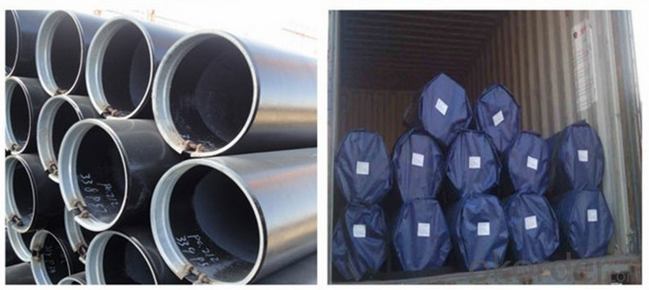
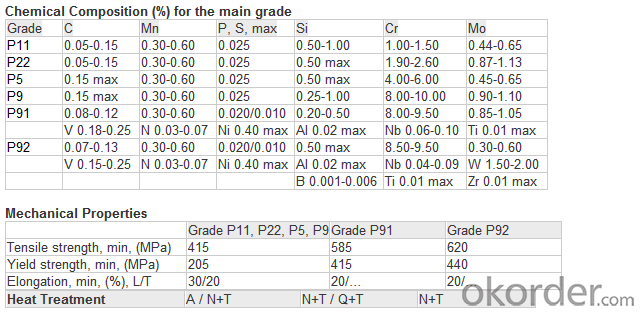
FAQ:
1) why you chose us ?
Professional Manufacturer and supplier of Steel pipe
More than 14 years’ professional producing experience
We can get the lowest ex-factory prices. The price are quite reasonable and it is lower than our commercial peers. also, we can guarantee the qualities of our products.
BV, ISO certificates and SGS test can be provided to assure the quality of our products.
2) Our minimum order quantity:
10 Metric Tons or one 20ft or 40ft Container.
3) How about the Delivery Time?
The steel pipe will be produced since we getting your deposit by T/T or Your original L/C. For normal size, some stocks in our factory now, we can supply once you need.
4)What kind of payment does your company support?
T/T, 100% L/C at sight, Cash, Western Union are all accepted.
5) Do you charge for the samples?
According to our company principle, we just charge for samples, you pay for the freight /courier charge.
6) Main market:
Mid East, South America, Africa, Southeast Asia, India etc
- Q: How do you prevent erosion in stainless steel pipes?
- To prevent erosion in stainless steel pipes, several measures can be taken. 1. Proper material selection: Choosing a high-quality grade of stainless steel with good resistance to erosion, such as 316 or duplex stainless steel, can significantly reduce the risk of erosion. 2. Corrosion-resistant coatings: Coating the internal surface of the stainless steel pipes with a corrosion-resistant material can provide an extra layer of protection against erosion. Epoxy coatings, for example, are commonly used to protect against erosion in pipes. 3. Flow control: Managing the flow rate and velocity of the fluid passing through the pipes is crucial in preventing erosion. High flow rates and excessive turbulence can accelerate the erosion process. Implementing flow control devices like flow restrictors or flow baffles can help regulate the fluid velocity, minimizing erosion. 4. Regular maintenance and inspection: Conducting routine inspections to identify any signs of erosion or corrosion is essential. This allows for timely repairs or replacements of affected sections before erosion becomes severe. Additionally, regular cleaning and flushing of the pipes can help remove any sediment or debris that may contribute to erosion. 5. Proper pipe installation: Ensuring that the pipes are properly installed and supported can help prevent damage caused by vibrations or excessive movement. Proper alignment and support can reduce stress on the pipes, minimizing the risk of erosion. 6. Fluid properties: Understanding the properties of the fluid being transported through the stainless steel pipes is important in preventing erosion. For instance, if the fluid contains abrasive particles, implementing filtration systems or using strainers can help remove these particles before they reach the pipes, reducing erosion. 7. Education and training: Providing education and training to personnel involved in the operation and maintenance of the pipes is crucial. This includes training on proper handling, maintenance, and troubleshooting techniques to identify and address erosion-related issues promptly. By implementing these preventive measures, erosion in stainless steel pipes can be effectively minimized, ensuring their longevity and optimal performance.
- Q: Where is the difference between seamless steel pipe and welded pipe?
- The steel tube is a hollow steel strip, used as pipe conveying fluid, such as oil, gas, water, gas, steam, in addition, the bending and torsional strength of the same, the weight is light, so it is widely used in the manufacture of machinery parts and engineering structures. It is also used to produce all kinds of conventional weapons, guns, shells and so on.
- Q: What are the common sizes and dimensions of stainless steel pipes?
- Different applications and requirements necessitate a variety of sizes and dimensions for stainless steel pipes. The pipes' nominal pipe size (NPS), which denotes their inner diameter, is typically used to classify the common sizes and dimensions. Stainless steel pipes commonly come in sizes ranging from 1/8 inch to 36 inches in diameter. These sizes are widely used in industries like construction, oil and gas, chemical processing, and plumbing. However, it is also possible to have stainless steel pipes customized to meet specific needs. In terms of dimensions, stainless steel pipes usually adhere to standard schedules that specify their wall thickness. The most prevalent schedules are Schedule 5, Schedule 10, Schedule 40, and Schedule 80. Each schedule has a varying wall thickness, enabling different levels of pressure and strength. Furthermore, stainless steel pipes are available in various lengths, ranging from 20 feet to custom lengths based on the manufacturer and application. The standard length for stainless steel pipes is often 6 meters or 20 feet, but shorter or longer lengths can be requested or cut to fit specific project requirements. It is crucial to consider other factors when selecting stainless steel pipes, such as material grade, corrosion resistance, temperature and pressure ratings, and adherence to industry standards. To ensure the correct choice of stainless steel pipes for a specific application, it is advisable to consult with a professional or refer to the appropriate standards and specifications.
- Q: What is the weight of a stainless steel pipe?
- The weight of a stainless steel pipe depends on various factors such as its diameter, wall thickness, and length. Stainless steel pipes are generally denser than other materials due to their high iron and chromium content. To calculate the weight, one needs to know the specific dimensions of the pipe and consult a weight chart or use a formula. For example, the weight per foot of a stainless steel pipe can be calculated by multiplying the pipe's cross-sectional area (πr²) by its length and then multiplying it by the density of stainless steel.
- Q: Are stainless steel pipes suitable for offshore platforms?
- Yes, stainless steel pipes are suitable for offshore platforms. Stainless steel is a corrosion-resistant material that can withstand the harsh marine environment, including exposure to seawater, salt, and other corrosive agents. It offers excellent resistance to oxidation and pitting, which are common issues in offshore environments. Stainless steel pipes are widely used in offshore platforms for various applications, such as transporting fluids and gases, structural supports, and as protective barriers. They are known for their high strength, durability, and reliability, which are crucial factors in offshore operations where safety is of utmost importance. Furthermore, stainless steel pipes have low maintenance requirements, reducing the need for frequent inspections and repairs. This is particularly advantageous in offshore settings where accessibility and maintenance can be challenging due to remote locations and harsh weather conditions. In addition to its corrosion resistance, stainless steel also offers other desirable properties such as heat resistance, fire resistance, and excellent mechanical properties. These characteristics make stainless steel pipes an ideal choice for offshore platforms, where they can be exposed to high temperatures, fire hazards, and mechanical stress. Overall, stainless steel pipes provide a cost-effective and long-lasting solution for offshore platforms, ensuring the safety, reliability, and efficiency of operations in these challenging environments.
- Q: How do you calculate the maximum allowable span for stainless steel pipes?
- The maximum allowable span for stainless steel pipes can be calculated by considering various factors such as the material's tensile strength, the pipe's diameter, wall thickness, and the type of support or loading conditions. By using engineering formulas and standards specific to stainless steel pipes, such as those provided by ASME B31.1 or ASME B31.3, one can determine the maximum span that ensures structural integrity and safety.
- Q: What is the maximum operating temperature for stainless steel pipes?
- The specific grade of stainless steel used can cause the maximum operating temperature for stainless steel pipes to vary. Nevertheless, stainless steel pipes, on the whole, can endure high temperatures. Typically, austenitic stainless steel grades like 304 and 316 are capable of handling temperatures up to 870°C (1600°F). Conversely, ferritic stainless steel grades like 430 have a lower maximum operating temperature of approximately 760°C (1400°F). To determine the precise maximum operating temperature for a specific stainless steel grade and pipe, it is crucial to refer to the manufacturer's specifications and guidelines.
- Q: What is the maximum length of a stainless steel pipe that can be manufactured?
- The maximum length of a stainless steel pipe that can be manufactured depends on various factors such as the manufacturing process, equipment capabilities, and logistical constraints. Generally, stainless steel pipes can be manufactured in lengths ranging from a few meters up to several hundred meters, depending on these factors.
- Q: Can stainless steel pipes be used for nuclear power applications?
- Yes, stainless steel pipes can be used for nuclear power applications. Stainless steel is known for its corrosion resistance, high strength, and ability to withstand high temperatures, making it suitable for various demanding environments, including nuclear power plants. Additionally, stainless steel's low reactivity with nuclear materials and its ability to maintain structural integrity under radiation exposure further make it a preferred choice for nuclear power applications.
- Q: What are the common sizes of stainless steel pipes?
- The common sizes of stainless steel pipes vary depending on their intended use and industry standards. However, some of the most common sizes include 1/8 inch, 1/4 inch, 3/8 inch, 1/2 inch, 3/4 inch, 1 inch, 1 1/4 inch, 1 1/2 inch, 2 inch, 2 1/2 inch, 3 inch, 4 inch, 5 inch, 6 inch, 8 inch, 10 inch, 12 inch, 14 inch, 16 inch, 18 inch, 20 inch, 24 inch, and 36 inch. These sizes are typically measured based on the outside diameter (OD) of the pipe. It is important to note that these sizes may vary slightly depending on the specific standards followed by the manufacturer or industry.
Send your message to us
A335 Seamless Ferritic Alloy-Steel Pipe for High-Temperature Service
- Loading Port:
- Shanghai
- Payment Terms:
- TT OR LC
- Min Order Qty:
- 1000 kg
- Supply Capability:
- 10000 kg/month
OKorder Service Pledge
OKorder Financial Service
Similar products
Hot products
Hot Searches
Related keywords




